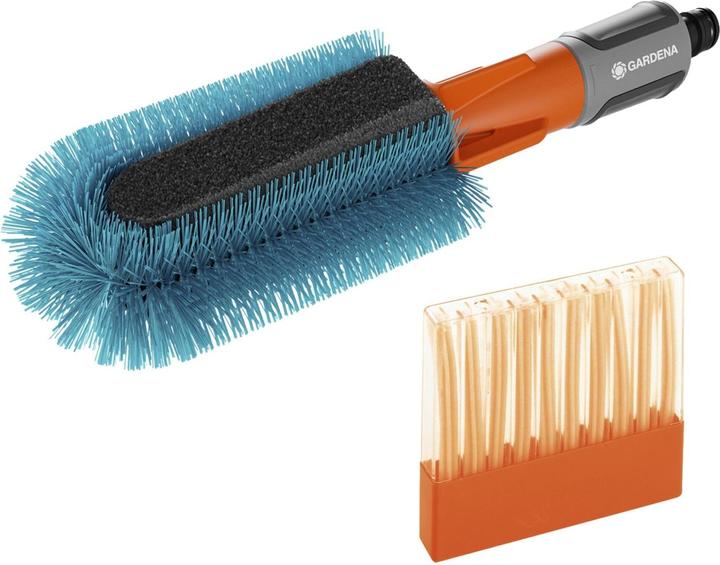

Zero joy with the 2-in-1 brush for bikes
I wash my bike too rarely. The bicycle brush from Gardena doesn't change that. The idea is nice, but the thing fails in use.
I love cycling. I hate cleaning my bike. Now the bike is dirty, it's less fun. I need to get out of this vicious circle - time for a thorough clean.
I found something I like in the shop: A 2-in-1 bicycle brush from Gardena. It is a brush that is both soft and hard. A foam element is supposed to clean the spokes or a handlebar smeared with pollen. With the hard bristles, on the other hand, I could get rid of the mud crust on the frame. At least that's my theoretical idea for the 2-in-1 part.
In practice, I experience disillusionment. This is also due to the way Gardena has designed the brush. A piece of foam is placed on the plastic part. A wire arch with hard plastic bristles runs over it in a U-shape. The inside of the U is then the soft foam sponge, and the surrounding area can be used for harder brushing.
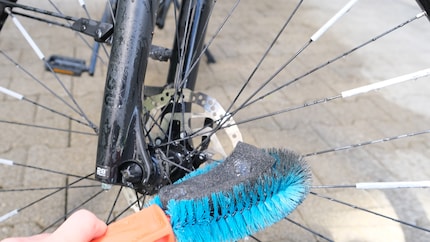
In use, three weaknesses become apparent that I would have expected to be strengths.
1. wet hands
The water coming from the hose keeps the sponge brush wet. But it still doesn't defy gravity. If I hold the brush too far upwards, the water flows over my hand - and into my sleeve, great!
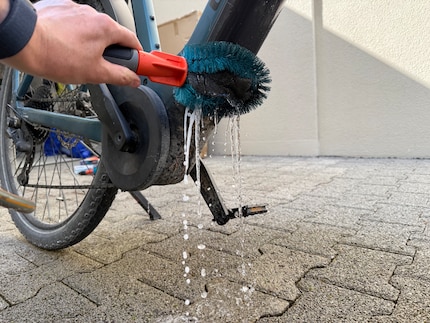
2. water distribution into the brush
I would have liked the water to come out of the brush more evenly. However, this would have required more than the four holes that Gardena has given the brush.
At least: Enough water gets through and I can regulate the flow rate on the handle. In my test, a maximum of ten litres flowed through in just under two minutes. This may be more or less for you, because it also depends on the pressure on your garden tap.
3. both-and instead of either-or
I can't use the softer foam element on its own. The bent brush is always with me when I want to use it. And conversely, it is unavoidable that the foam element also comes into contact with coarse dirt when brushing. If the bike brush accidentally comes into contact with the smeared chain, the result doesn't look so good afterwards.
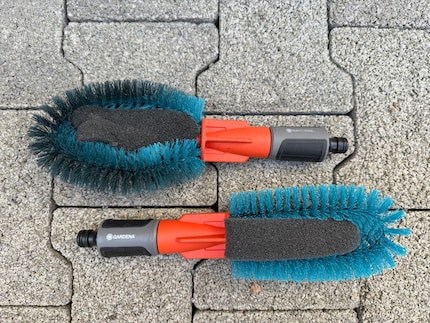
Troublesome spare part
The foam is a wearing part - and it wears out quickly. If it is torn in one place, the water from the shaft splashes directly into my face. (I'd rather have it in my sleeve then.)
At least there is a replacement. To change the foam, I bend the brush wire slightly to the side. Then I can pull the old piece of foam off the handle and put a new one on. The shaft of the handle is a bit tricky. The brushes and the foam are fighting for space there. My brush no longer looks as nice as new from the factory.
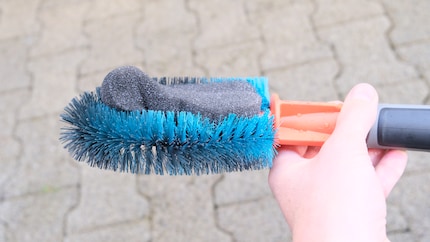
Better with soap?
My set also includes soap sticks. They are also available as a separate accessory.

You can use them if the dirty water is drained into a proper sewerage system. On a lawn, the soapy water should not seep into the ground. Or you can leave it alone. Because I can't see any noticeably better cleaning performance when tested.
Or am I the problem and using the brush incorrectly? Have you had other, perhaps even better experiences with the brush - share your knowledge in a comment.
In a nutshell
Good in theory, bad in practice
Contra
- Soap sticks without much effect
- Hard and soft brushes can hardly be used separately
- Foam wears out quickly
- Water follows confusing paths
Journalist since 1997. Stopovers in Franconia (or the Franken region), Lake Constance, Obwalden, Nidwalden and Zurich. Father since 2014. Expert in editorial organisation and motivation. Focus on sustainability, home office tools, beautiful things for the home, creative toys and sports equipment.
